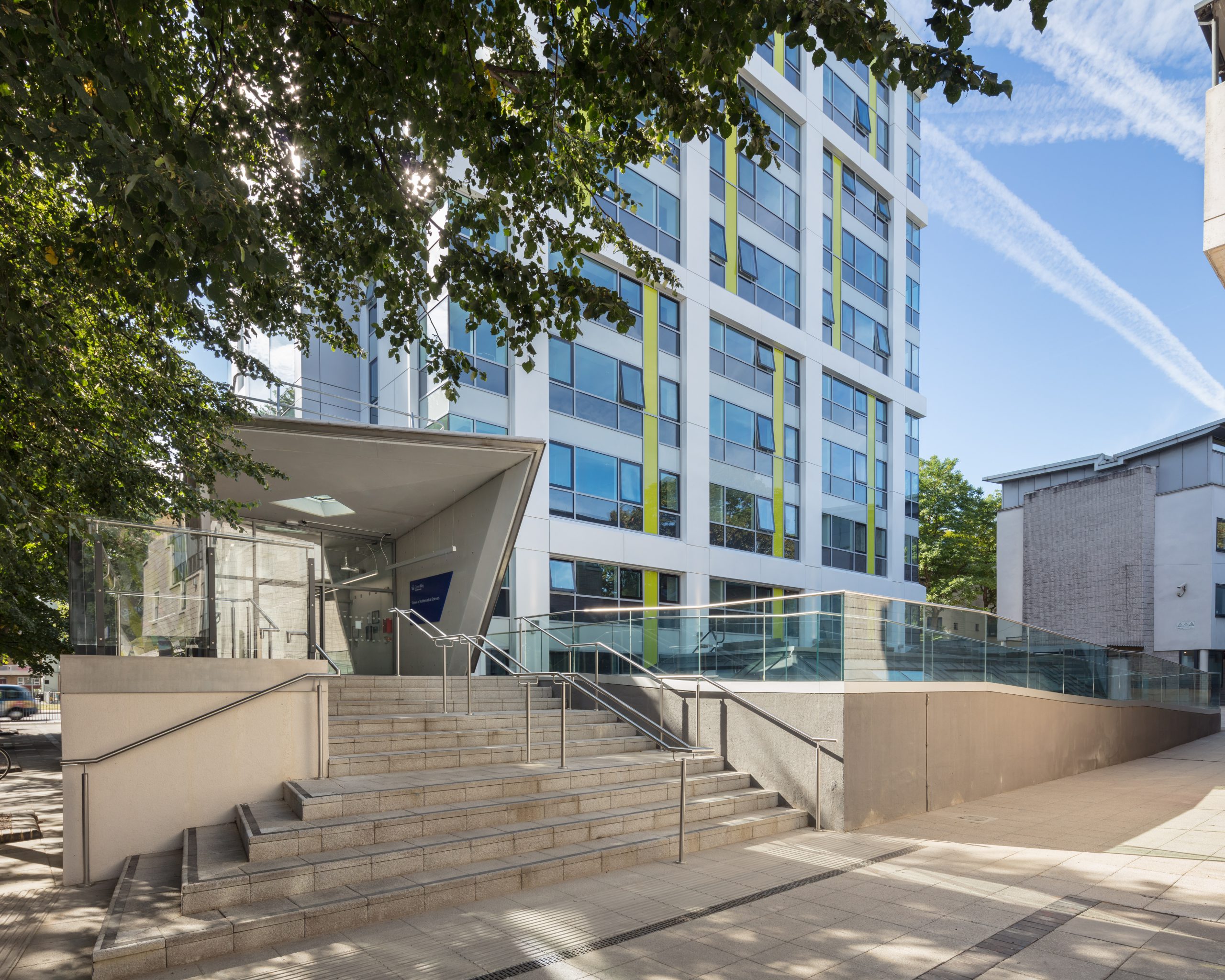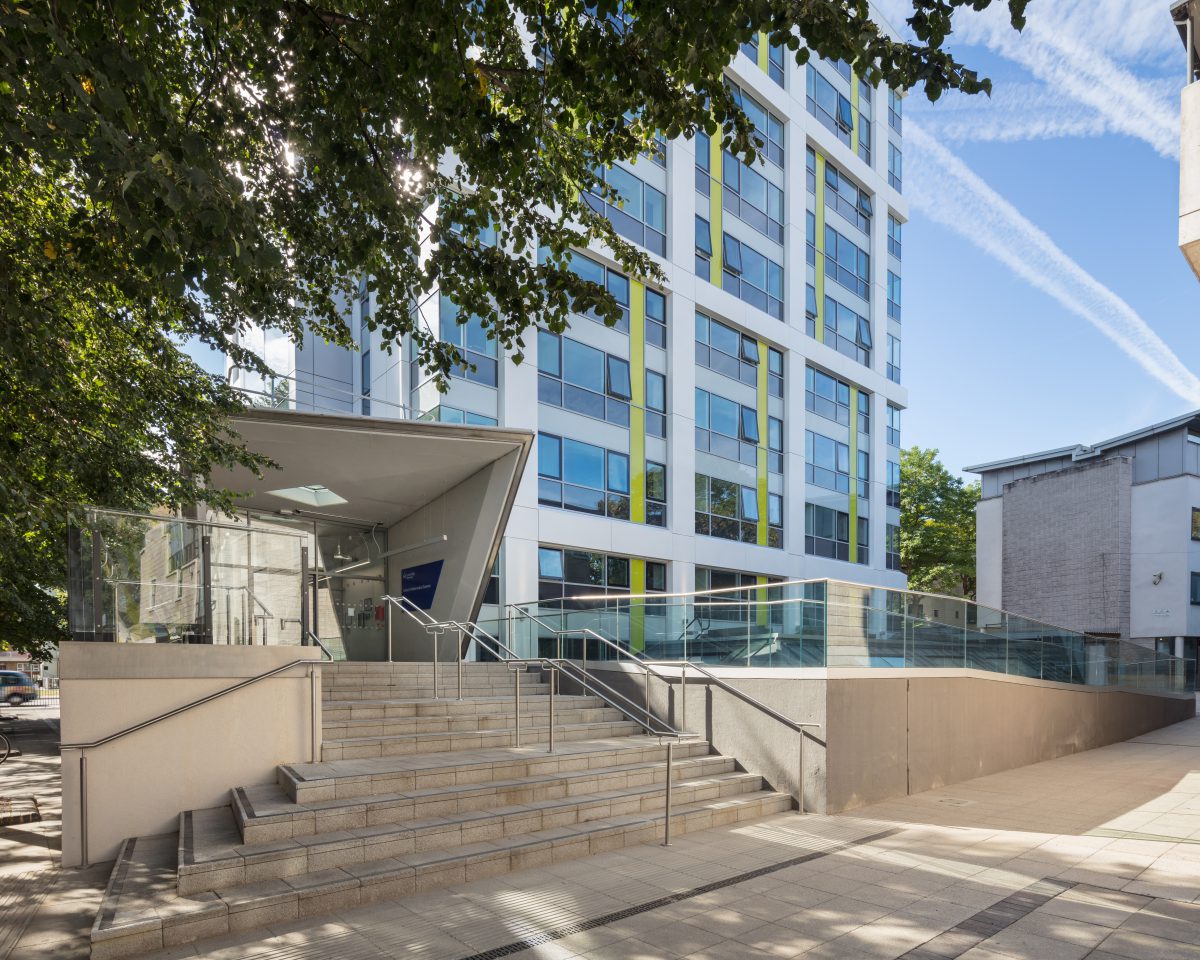Project Details
- Scheme & Version: BREEAM UK Refurbishment and Fit-out 2014: Education SD216 1.1 (Parts 1-4)
- Certification Stage: Final (Post Construction)
- Rating: Excellent
- Overall Score: 75.7%
Project Team
- Developer / Client: Queen Mary University of London
- Project Manager: Gardiner & Theobald LLP
- Architect: Kendall Kingscott Limited
- Architect (Fit Out): White Ink Architects
- Building Services: MLM Consulting Engineers Ltd
- Constructor: Graham
- Assessor Company: Scott White and Hookins LLP
About the Building
Queen Mary University of London (QMUL) is one of the UK’s leading universities, highly rated for its teaching, its research and its engagement activities at the local, national and international levels. With around 20,200 students and 4,000 staff, they are one of the biggest University of London colleges.
The School of Mathematical Sciences Building is located on the Mile End Road between Stepney Green and Mile End tube stations in the London Borough of Tower Hamlets. It occupies a very prominent, highly visible, urban site overlooking the City and is a main gateway on the west boundary of the Queen Mary, University of London’s Mile End campus.
The School of Mathematical Sciences is part of the University’s Faculty of Science and Engineering and occupies the split level 10 storey building. It was built for the Department of Mathematics in 1967 in a ‘brutalist’ style, with the reinforced concrete frame exposed externally and internally (within circulation areas).
Prior to the refurbishment works, the building was poorly ventilated with outdated, inefficient building systems along with a poorly performing building fabric. The south side of the building (which represents around 50% of the building on plan) had secondary glazing and relied solely on mechanical ventilation for fresh air. The north side of the building was single glazed and naturally ventilated.
The purpose of the redevelopment was to provide exceptional accommodation for academic/teaching staff as well as graduate and postgraduate students by reconfiguring existing spaces, circulation and facilities to provide a new lecture theatre, teaching spaces, academic spaces, social spaces and associated facilities.
The overall objective was to enhance the appearance of the building and the quality of the environment, whilst also vastly improving its energy efficiency. With the building being so prominent and forming a gateway to the campus, this included optimising existing spaces and improving the links between buildings on the campus. The buildings renewed spaces are specifically designed to facilitate interaction and conversation whilst also providing quiet spaces for original thinking and relaxation.
The studies of the building prior to its refurbishment had identified it as being no longer “fit for purpose”. Primary considerations and key project objectives included:
- Refurbishment and extension of the existing building to provide suitable accommodation for the School of Mathematical Sciences.
- Upgrade the building envelope to improve air tightness, thermal performance and acoustic performance as well as meeting the University’s Carbon Strategy and EnerPHit certification.
- Upgrade the building envelope to also improve appearance- reflecting the buildings prominent location.
- Enhancing the approach and access, including integrating this with the ground floor extension.
- Maximise reuse of existing structure to reduce waste.
- Reconfigure existing space and adding new study/tutorial areas, as well as new social spaces.
- Reduce energy usage and carbon emissions whilst also including consideration of whole life costs and overall project affordability.
- Targeting a BREEAM ‘Excellent’ Rating overall.
- Safe removal of asbestos containing materials.

Management – Early engagement of the team and specialist appointments made at the appropriate stages allowed the majority of the management credits to be targeted and achieved. This allowed 18/21 Management credits to be awarded.
Health and Wellbeing – During the design development, close attention was paid to coordinating and integrating the structure and the occupied areas of the development including;
· Solar shading.
· Lighting Controls.
· High Frequency Lighting.
· Minimising internal areas requiring mechanical ventilation.
· Minimising direct solar gain to avoid air conditioning/comfort cooling.
· Maximising daylight factors in all areas.
These features allowed 15/18 Health and Well-being credits to be awarded.
Energy – The environmental services proposals were designed using the latest techniques for “active and passive” energy recovery and conservation including:
· Maximising utilisation of plant and systems.
· Maximising control and flexibility of the installations.
· Heat Recovery of all Plant and Systems.
· Full Integrated BMS Coverage.
Water – Water saving devices and fittings were used throughout the development to achieve maximum water consumption credits and a 55.39% improvement over baseline performance. Major leak detection and flow control devices were installed to minimise water wastage. Maximum credits were subsequently achieved within the water category.
This allowed 9/9 Water credits to be awarded.
Land Use and Ecology – Land Use and Ecology criteria were maximised by installation of Bird and Bat Boxes and a living wall within the development.
This allowed 3/4 Land Use and Ecology credits to be awarded.
Transport – Transport links to the development are excellent with the nearest stations on the London Underground being Mile End on Hammersmith and City, District and Central lines and Stepney Green on the Hammersmith and City and District lines.
This allowed maximum Public Transport Accessibility credits to be achieved and 7/9 Transport credits overall to be awarded.
Environmental Challenges and Green Strategy
As an existing 1960’s building that had been deemed not “fit for purpose”, the initial thoughts are often demolish and rebuild a more energy efficient building from scratch. However, this would have led to a large amount of demolition and construction waste as well as new materials being brought to site, therefore increasing the University’s carbon emissions.
The University’s Green Strategy included carrying out extensive reviews of the existing building to assess elements that could viable and efficiently be maintained as part of the refurbished solution, whilst not compromising on its final performance. This resulted in re-use the existing building and upgrading the existing façade to improve thermal performance and air tightness and updating building services elements to reduce energy use and carbon emissions.
Main building/environmental challenges included:
- Fabric upgrade reducing energy use and carbon emissions
- Building services renewal including centralised equipment as appropriate
- Energy saving devices and fittings
- Lift modernisation
- Water saving devices and fittings
- Photovoltaic panels to supplement energy supply
Whilst targeting high scoring throughout, BREEAM also focused the team specifically on Energy, Water and Health and Wellbeing- in line with the project goals of an exception environment for users and vastly improved operational resource use efficiency. By targeting the relevant credits and setting early-stage targets to achieve a 40% carbon reduction over the existing building and minimise water consumption and waste, BREEAM became a key driver to achieving the Client’s requirements.
Passive design analysis at an early stage allowed the existing orientation and location to be considered when reconfiguring the existing space. Larger teaching spaces were located on the southern elevation which benefitted from daylighting but would also suffer solar gains in summer. This was then reviewed and considered further through thermal modelling to allow the area to achieve maximum thermal comfort including an allowance for climate change within the strategy.
Photovoltaic Panels were also incorporated as a Low Zero Carbon strategy to further improve carbon reduction.
Water saving devices and fittings were used throughout the development to achieve maximum water consumption credits and a 55.39% improvement as well as installation of major leak detection and flow control devices to minimise water wastage. Maximum credits were subsequently achieved within the water category.

Benefits of achieving BREEAM certification
The BREEAM process was very enlightening and enabled sustainability principles to be embedded in the project from an early stage. This provided the University with a sustainable and energy efficient building for the benefit of staff and students. Notable strategies included a high performing façade, natural ventilation, energy efficient HVAC and lighting and photovoltaic panels.
-Harry Pluckrose, Project Manager, Partner Gardiner & Theobald Project Management

